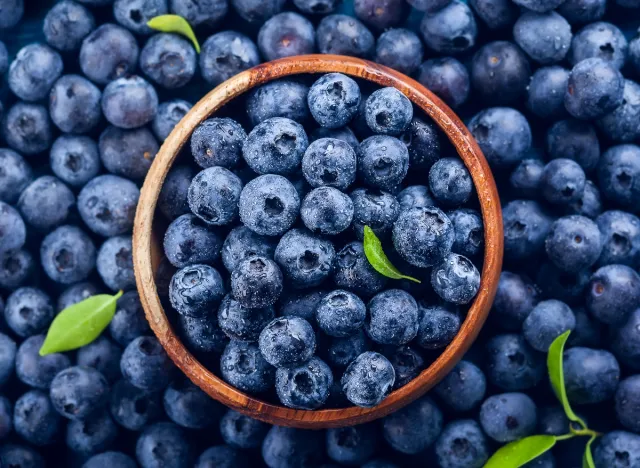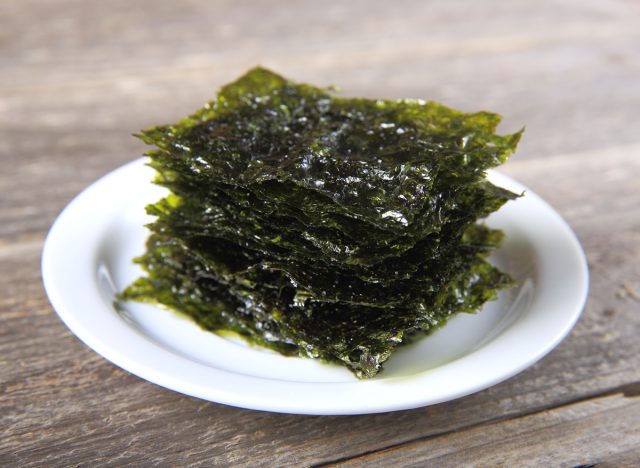Just as you have a playlist for your collection of digital music to get to your favorite tunes quickly, you need a playlist of healthy low-calorie superfoods to make your body sing. You know your favorite foods by heart, but they’re probably not the healthiest to eat every day. But can you rattle off a checklist of super-healthy foods that’ll energize your body and prime it against illness for the fewest calories?
Right. That’s why we can all use a playlist of favorite low-calorie superfoods to work into our meal and snack rotation every day. Here’s an inventory of the best that you can choose from as recommended by expert dietitians. Read on, and for more, don’t miss The 7 Best Fruits You Should Be Eating Every Day, Say Dietitians.


Snack on this superfood as often as you like. “Clocking in at around 80 calories per cup, fresh blueberries are not just low in calories, but high in brain health-boosting antioxidants,” says Eatthis.com medical review board member Lisa Moskovitz, RD, CEO of NY Nutrition Group and author of The Core 3 Healthy Eating Plan.
“Studies show blueberries can fight against age-related memory loss,” she says. The powerful brain-boosting compounds in berries are flavonoids. Blueberries are also a top source of vitamin C, vitamin K, and digestion-regulating fiber.


“Kale originated as a garnish but has now become one of the leading, low-calorie superfoods,” says Moskovitz. This dark leafy green vegetable is an excellent source of nutrients such as vitamin K, magnesium, calcium, iron, vitamin C, and fiber. And you get all of that for just 10 calories per cup.


A medium apple packs just 95 calories—less than those 100-calorie snack packs of cookies. But an apple is much better for you because, well, you know what they say about an apple a day… Eat the skins; that’s where you’ll find all the good stuff, including fiber and a lot of healthful nutrients. Apples contain a variety of phytochemicals, including quercetin, catechin, phloridzin, and chlorogenic acid, all of which are strong antioxidants that a Nutrition Journal study suggests can help prevent the DNA damage that leads to cancer.


The deep red color of pomegranate seeds and their juice should tip you off to their high nutrient content. Pomegranates are loaded with polyphenols, compounds that are believed to protect the body against oxidative stress and reduce risk of inflammation, heart disease, and cancers. Choose a high quality, 100-percent pomegranate juice like POM Wonderful, which is whole-pressed to release polyphenols in the rind, pith, and arils, says medical review board member and registered dietitian Toby Amidor, MS, RD, author of Diabetes Create Your Plate Meal Prep Cookbook.
“An in vitro study at UCLA found that 100-percent pomegranate juice has more antioxidant potency than red wine, Concord grape juice, or green tea, on average,” she says. Pomegranate juice is also a good source of potassium, an important electrolyte for healthy muscle function.
Try Amidor’s recipe for Pomegranate-Lime-Mint Popsicles.
READ RELATED: What is Viagra Does it work? What are the side effects? How long does it last?


Greek yogurt is a great source of protein, and it contributes a significant dose of calcium, a nutrient most folks don’t get enough of. A 5.3-ounce single-serve container has around 80 calories and 14 grams of protein. “Pair Greek yogurt with fruit, granola, or nuts to increase fiber, another nutrient that’s under-consumed by most Americans,” says Amidor. “A few of my favorite snack recipes with non-fat Greek yogurt include Berry Smoothie, Apple Pie Parfaits, or Lemon-Raspberry Protein Popsicles.”


“All non-starchy vegetables in my opinion are superfoods,” says Eatthis.com medical review board member and registered dietitian Amy Shapiro, MS, RD, founder of Real Nutrition. “They fill you up with fiber, vitamins, minerals, and water, helping you to fight free radicals, and prevent aging and illness,” For a full list of non-starchy vegetables, check out the American Diabetes Association website.


The Japanese have very low rates of colorectal cancer, which led researchers to look into a possible connection to eating seaweed, a popular dish in Japan. In one study, researchers found that red seaweed may have a protective effect against cancer. You can now commonly find fresh seaweed salad at most grocery stores. And it’s also available in dried sheets as snacks. “I love the seaweed snacks by Gimme Snacks, as they are crunchy, salty, and very low-calorie but rich in minerals including iodine needed for hormone management,” says Shapiro.


Like any leafy green, spinach is super low in calories but packs a huge nutritional wallop. For one, spinach is high in iron and magnesium, two nutrients linked to healthy calorie-burning metabolism. “Greens (like spinach) are always a ‘go-to,’ because they are filling, high in water volume, and nutrient-rich with lutein and zeaxanthin to protect your eyes from macular degeneration,” says Shapiro.


Even though they are tiny, seeds are considered a superfood because they contain so much good stuff: healthy fats, protein, fiber, vitamins, and minerals. Gram-for-gram, seeds are technically high in calories, but because the usual portion size is small, they can still be called a “low-cal superfood.”
Some of the best are pumpkin seeds (126 calories per ounce), which are high in magnesium to keep blood sugar, your mood, and sleep in check; sunflower seeds (51 calories per tablespoon), one of the richest sources of vitamin E; hemp seeds (55 calories per tablespoon), a fantastic source of plant-based protein; and both chia and flax seeds (55 calories per tablespoon), which are high in fiber for digestive health and plant-based omega-3 fatty acids.


Pick up any diet book and you’ll find broccoli recommended as a superfood. Not only is it low in calories, but it’s also rich in sulforaphane, a compound that research indicates fights off body fat storage. Growing clinical evidence suggests this phytochemical compound is effective in preventing and treating various cancers, such as prostate cancer, breast cancer, colon cancer, skin, urinary bladder, and oral cancers, according to the American Institute of Cancer Research.


A ½-cup serving of this colorful root vegetable packs a cornucopia of health benefits in only 41 calories. For starters, carotenoids, the pigments that give carrots and other vegetables their orange, red, yellow, and purple colors, may provide anti-inflammation and anti-cancer effects, according to research in the British Journal of Pharmacology.
Carrots also contain the powerful antioxidants lutein and zeaxanthin, which may prevent macular degeneration, a common age-related disorder that leads to vision loss. And the eye health benefits don’t stop there—that half a cup of raw baby carrots provides 51% of your daily requirement of vitamin A, a critical nutrient for your vision.
Source:











